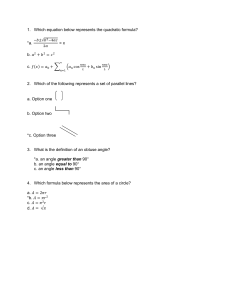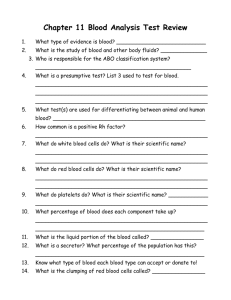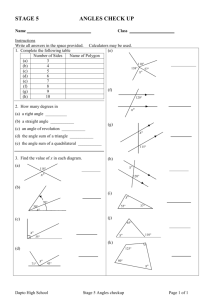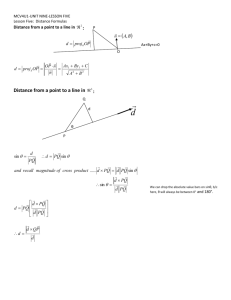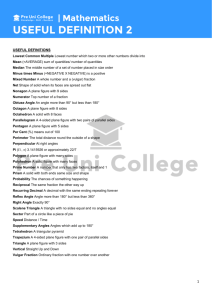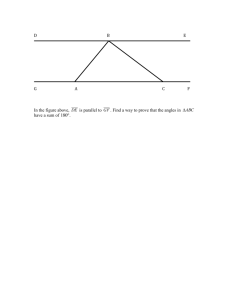Angles in 3D world - Tak Sun Secondary School Personal Web Server
advertisement
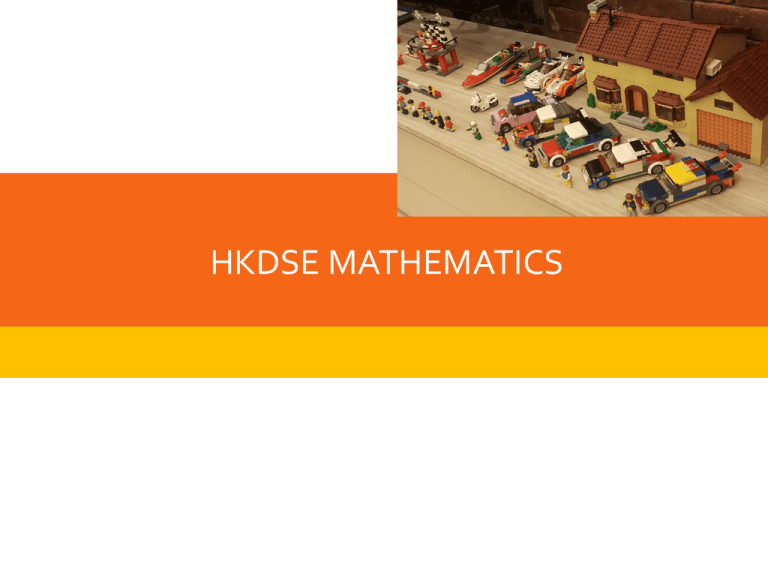
HKDSE MATHEMATICS Ronald Hui Tak Sun Secondary School HOMEWORK SHW6-01, 6-A1 Deadline: 11 Jan 2016 No more delay please 22 October 2015 Ronald HUI SUMMARY OF 2D TRIGONOMETRY Ronald Hui Tak Sun Secondary School Similarly, for any △ABC, we have: 1 ab sin C 2 1 = bc sin A 2 1 = ac sin B 2 the included angle of a and b. Area of △ABC = A b c B a C the included angle the included angle of b valid and cfor . right-angled triangles. Note: The above formula is also of a and c. When C = 90, area of △ABC 1 1 1 ab sin C ab sin 90 ab 2 2 2 Heron’s formula Area of △ABC s(s a)(s b)(s c) , where s abc . 2 s is called the semi-perimeter. B A b c a C The sine formula A In △ABC, a b c = = sin A sin B sin C c B It can also be written as sin B sin C sin A a = b = c b a Note: By the sine formula, we have: 1. a b b c a c , and sin A sin B sin B sinC sin A sinC 2. sin A : sin B : sin C = a : b : c C In fact, for any △ABC, we have c2 = a2 + b2 2ab cos C Similarly, we can prove that b2 = a2 + c2 2ac cos B and a2 = b2 + c2 2bc cos A. The above results are known as the cosine formula. The cosine formula In △ABC, A a2 = b2 + c2 2bc cos A, b2 = a2 + c2 2ac cos B, c2 = a2 + b2 2ab cos C. b c B a C The cosine formula can also be written as follows: In △ABC, b2 c 2 a2 cos A , 2bc a2 c 2 b2 cos B , 2ac a2 b2 c 2 cos C . 2ab C a b A c B The cosine formula is also known as the cosine law or the cosine rule. In the figure, CB and AD are horizontal lines. C horizontal line B angle of depression of A from B angle of elevation of B from A A horizontal line D We can see that: Angle of elevation Angle of depression = of B from A of A from B alt. s, AD // CB True Bearing and Compass Bearing To describe the direction of a point relative to another True Bearing point, true bearing or compass bearing may be used. N Directions are measured from the P north in a clockwise direction. O It is expressed as x, where (i) 0 x < 360, (ii) the integral part of x must consist of 3 digits. N Refer to the figure on the right, 58 the true bearing of P from O is 058, P O the true bearing of Q from O is 220. 40 Q 180 + 40 = 220 True Bearing and Compass Bearing Compass Bearing N60W N N40E P Q 60 40 W S E O 70 25 R S S70W S25E Directions are measured from the north or the south. It is expressed as NxE, NxW, SxE or SxW, where 0 < x < 90. Book 5A Chapter 6 Basic Terminologies in 3-dimensional Problems Angle between Two Intersecting Straight Lines The figure shows two non-parallel straight lines AB and CD. They intersect each other at a point E. D A C E The acute angle formed is called the angle between two straight lines. B If the two lines are perpendicular to each other, then the angle between the two lines is 90. P S R Q Angle between Two Intersecting Straight Lines The figure shows two non-parallel straight lines AB and CD. They intersect each other at a point E. D A C E The acute angle formed is called the angle between two straight lines. B How about ∠AED and ∠CEB? Are they also called the angle between two straight lines? Angle between Two Intersecting Straight Lines The figure shows two non-parallel straight lines AB and CD. They intersect each other at a point E. D A C E The acute angle formed is called the angle between two straight lines. B No, these obtuse angles are NOT considered as the angle between the two straight lines. Can you identify the angle between the lines AC and AG? H ∵ AC and AG intersect at A . ∴ The angle between the lines AC and AG is ∠GAC . E G F D A C B Follow-up Question The figure shows a cube ABCDEFGH. Identify the angles between (a) the lines BG and GH, E H G F (b) the lines AD and BD, D C (c) the lines AC and CF. A B (a) ∵ BG and GH intersect at G. ∴ The angle between the lines BG and GH is BGH. Follow-up Question The figure shows a cube ABCDEFGH. Identify the angles between (a) the lines BG and GH, E H G F (b) the lines AD and BD, D C (c) the lines AC and CF. A B (b) Join BD. ∵ AD and BD intersect at D. ∴ The angle between the lines AD and BD is ADB. Follow-up Question The figure shows a cube ABCDEFGH. Identify the angles between (a) the lines BG and GH, E H G F (b) the lines AD and BD, D C (c) the lines AC and CF. A B (c) Join AC and CF. ∵ AC and CF intersect at C. ∴ The angle between the lines AC and CF is ACF. Angle Between a Straight Line and a Plane In the figure, P is a point lying outside the plane . Q is a point on the plane such that PQ is perpendicular to any straight line on passing through Q (e.g. L1 and L2). Then, P (i) PQ plane L1 Q L2 (ii) Q is the projection of P on the plane . Angle Between a Straight Line and a Plane In the figure, a straight line AB intersects the plane at the point A. C is the projection of B on the plane . Then, (ii) BAC is the angle between the line AB and the plane . B C A (i) AC is the projection of AB on the plane . Can you identify the angle between the line FD and the plane ABCD? H ∵ ∴ BD is the projection of FD on the plane ABCD. The angle between the line FD and the plane ABCD is ∠FDB . E G F D A C B Follow-up question The figure shows a right triangular prism with ∠ABC = ∠DEF = 90. Identify the angles between (a) the line AF and the plane ADEB. (b) the line AF and the plane DEF. A C B D F (a) Join AF. E ∵ AE is the projection of AF on the plane ADEB. ∴ The angle between the line AF and the plane ADEB is ∠FAE. Follow-up question The figure shows a right triangular prism with ∠ABC = ∠DEF = 90. Identify the angles between (a) the line AF and the plane ADEB. (b) the line AF and the plane DEF. A C B D F (b) ∵ DF is the projection of AF on the plane DEF. ∴ The angle between the line AF and the plane DEF is ∠AFD. E After identifying angles in three Let’s see solve dimensions, wehow can to find theirthe sizes followingtrigonometric problems. by applying knowledge. H E F 4 cm F 6 cm D A E G D C 5 cm C 10 cm B Angle between the lines CH and CD = ? A 12 cm B Angle between the line AF and the plane ABCD = ? The figure shows a rectangular block ABCDHEFG. AB = 10 cm and AE = 6 cm. Find the angle between the lines CD and CH, correct to 1 decimal place. H G E F 6 cm D A C 10 cm B Step 1: Identify the required angle. ∵ CD and CH intersect at C. ∴ The angle between the lines CD and CH is DCH. The figure shows a rectangular block ABCDHEFG. AB = 10 cm and AE = 6 cm. Find the angle between the lines CD and CH, correct to 1 decimal place. H E G F 6 cm D A 10 cm Step 2: Analyse the information needed to find the required angle. Do you know the lengths of any side Yes, I know the lengths of △CDH? of CD and DH. C B The figure shows a rectangular block ABCDHEFG. AB = 10 cm and AE = 6 cm. Find the angle between the lines CD and CH, correct to 1 decimal place. H E G F 6 cm D A 10 cm Step 2: Analyse the information needed to find the required angle. Then you can find ∠DCH by using CD = AB = 10 cm and trigonometric ratio. DH = AE = 6 cm C B The figure shows a rectangular block ABCDHEFG. AB = 10 cm and AE = 6 cm. Find the angle between the lines CD and CH, correct to 1 decimal place. Solution H E G F 6 cm D A C 10 cm B The angle between the lines CD and CH is ∠DCH. DC = AB = 10 cm DH = AE = 6 cm Consider △CDH. ∴ The angle between the lines DH CD and CH is 31.0. tan DCH DC 6 cm 10 cm DCH 31.0 (cor. to 1 d.p.) In some cases, Pythagoras theorem is also useful in finding the angles. The figure shows a right triangular prism ABCDEF. AB = 12 cm, BC = 5 cm, CF = 4 cm and ∠BCF = ∠ADE = 90. Find the angle between the line AF and the plane ABCD, correct to 3 significant figures. E F 4 cm D C 5 cm A 12 cm Step 1: Identify the required angle. ∵ AC is the projection of AF on the plane ABCD. ∴ The angle between the line AF and the plane ABCD is ∠FAC. B The figure shows a right triangular prism E F ABCDEF. AB = 12 cm, BC = 5 cm, 4 cm CF = 4 cm and ∠BCF = ∠ADE = 90. D Find the angle between the line AF and C the plane ABCD, correct to 3 significant 5 cm A figures. 12 cm B Step 2: Analyse the information needed to find the required angle. In △ACF, CF = 4 cm AC = ? AF = ? Consider we can Then△ABC, we have use Pythagoras theorem enough information totofind length findthe ∠FAC. of AC. The figure shows a right triangular prism ABCDEF. AB = 12 cm, BC = 5 cm, CF = 4 cm and ∠BCF = ∠ADE = 90. Find the angle between the line AF and the plane ABCD, correct to 3 significant figures. Solution E F 4 cm D C 5 cm A 12 cm B The required angle is FAC. Consider △ACF. CF Consider △ABC. tan FAC AC 2 2 ◄ Pyth. theorem AC AB + BC 4 cm 13 cm 122 + 52 cm FAC 17.1 13 cm (cor. to 3 sig. fig.) ∴ The angle between the line AF and the plane ABCD is 17.1. Follow-up question H G The figure shows a rectangular block ABCDHEFG. AB = 8 cm, BC = 6 cm E F and AE = 7 cm. Find the angle between 7 cm D the line CE and the plane ABCD, C correct to 3 significant figures. 6 cm A 8 cm B ∵ CA is the projection of CE on the plane ABCD. ∴ The angle between the line CE and the plane ABCD is ∠ECA. Consider △ABC. AC AB2 + BC2 ◄ Pyth. theorem 82 + 62 cm 10 cm Follow-up question H G The figure shows a rectangular block ABCDHEFG. AB = 8 cm, BC = 6 cm E F and AE = 7 cm. Find the angle between 7 cm D the line CE and the plane ABCD, C correct to 3 significant figures. 6 cm A 8 cm B Consider △ACE. AE tan ECA AC 7 cm 10 cm ECA 35.0 (cor. to 3 sig. fig.) ∴ The angle between the line CE and the plane ABCD is 35.0. Angle Between Two Intersecting Planes It is given that plane 2 intersects plane 1 at a straight line AB. A 2 B 1 AB is the line of intersection of the two planes. Angle Between Two Intersecting Planes If PX is a line on plane 1 such that PX AB and PY is a line on plane 2 such that PY AB, then X A P 2 P is a point on AB. 1 Y B The acute angle between PX and PY is the angle between the planes 1 and 2. Can younotice identify theDH angle between Do Therefore, you the that required ⊥angle AD the ADHE and AFGD? and can planes also DG ⊥beAD? ∠HDG. H AD is the line of intersection of the planes ADHE and AFGD. E G F D ∵ AE ⊥ AD and FA ⊥ AD ∴ A The angle between the planes ADHE and AFGD is ∠EAF. (or ∠HDG) C B If AE = 14 cm and AF = 20 cm, can you find the angle between the planes ADHE and AFGD, correct to 3 significant figures? The required angle is ∠EAF. Consider △AEF. H E G F 20 cm AE 14 cm cos EAF AF D C 14 cm B A 20 cm EAF 45.6 (cor. to 3 sig. fig.) ∴ The angle between the planes ADHE and AFGD is 45.6. Follow-up question E F The figure shows a triangular prism ABCDEF, where ABCD, CFED and ABFE are rectangles. It is given that AE = 12 cm, BC = 10 cm and 12 cm C D ∠BCF = 90. 10 cm (a) Identify the angle between the A B planes BEF and CDEF. (b) Find the angle mentioned in (a), correct to 3 significant figures. (a) EF is the line of intersection of the planes BEF and CDEF. ∵ BF ⊥ EF and CF ⊥ EF ∴ The angle between the planes BEF and CDEF is BFC. Follow-up question E F The figure shows a triangular prism ABCDEF, where ABCD, CFED and ABFE are rectangles. It is given that AE = 12 cm, BC = 10 cm and 12 cm C D ∠BCF = 90. 10 cm (a) Identify the angle between the A B planes BEF and CDEF. (b) Find the angle mentioned in (a), correct to 3 significant figures. (b) Consider △BCF. BC sin BFC BF 10 cm BF = AE = 12 cm 12 cm BFC 56.4 (cor. to 3 sig. fig.) ∴ The angle mentioned in (a) (i.e. BFC) is 56.4. Line of Greatest Slope The figure shows an inclined road with two paths AX and BX. X Let us compare I will choose the of the theslopes path that is paths AXsteep. and BX. less Y A B Which path do you choose to reach X? Line of Greatest Slope X Consider BXY. XY Slope of BX = BY Consider AXY. Y X XY Slope of line segment Slope of AX = AY = vertical distance So, I let willus choose the Now, Here, we can study see how that horizontal distance AY < BY ∵ path to reach X. to different find BX thestraight line with lines the 1 1 < greatest on an inclined slope on road an ∴ BY AY have inclined different plane. slopes. XY XY < ∴ BY AY i.e. Slope of BX < slope of AX A B Line of Greatest Slope The figure shows an inclined plane ABEF. It intersects the horizontal plane ABCD at AB. If PX AB, the slope of PX is the greatest. X PX is the line of greatest slope of the inclined plane ABEF. P The figure shows a hillside ABCD sloping to the horizontal ground ABEF. ABCD is a rectangle. It is given that CE = 4 cm and BE = 15 cm and ∠BEC = 90. A D C 4 cm F E 15 cm B Find the inclination of the line of greatest slope of the hillside ABCD. (Give your answer correct to 3 significant figures.) The figure shows a hillside ABCD sloping to the horizontal ground ABEF. ABCD is a rectangle. It is given that CE = 4 cm and BE = 15 cm and ∠BEC = 90. A D C 4 cm F E 15 cm B ∵ AB is the line of intersection of the inclined plane ABEF and the horizontal plane ABCD, and BC ⊥ AB. ∴ BC is the line of greatest slope of the hillside ABCD. The figure shows a hillside ABCD sloping to the horizontal ground ABEF. ABCD is a rectangle. It is given that CE = 4 cm and BE = 15 cm and ∠BEC = 90. A D C 4 cm F E 15 cm B Consider △BCE. CE tan CBE BE 4 cm 15 cm CBE 14.9 (cor. to 3 sig. fig.) ∴ The inclination of the line of greatest slope of the hillside ABCD is 14.9. Follow-up question The figure shows a rectangular board ABCD sloping to a horizontal plane. E and F are the projections of the points C and D on the horizontal plane respectively. It is given that CE = 5 cm, A AB = 18 cm and BAC = 38. D C 5 cm E F 38 18 cm B (a) Find the length of the line of greatest slope of the plane ABCD. (b) Find the inclination of the line of greatest slope of the plane ABCD. (Give your answers correct to 3 significant figures.) C D 5 cm E F A 38 18 cm B (a) BC is the line of greatest slope of the plane ABCD. Consider △ABC. BC tan BAC AB BC tan 38 18 cm BC 18 tan 38 cm 14.1 cm (cor. to 3 sig. fig.) ∴ The length of the line of greatest slope is 14.1 cm. D BC 18 tan 38 cm C 5 cm E F A 38 18 cm B (b) ∠CBE is the inclination of the line of greatest slope of the plane ABCD. Consider △BCE. sin∠CBE CE BC 5 cm 18 tan 38 cm ∠CBE 20.8 (cor. to 3 sig. fig.) ∴ The inclination of the line of greatest slope of the plane ABCD is 20.8. Distance between a Point and a Line Consider a straight line L and a point P not lying on L. If Q is a point on L such that PQ is perpendicular to the line L, then, P PQ is the distance between the point P and the line L. Note: PQ is also the shortest distance between the point P and the line L. L Q Example: The figure shows a cuboid ABCDEFGH. It is given that AB = 9 cm, BC = 8 cm F and AF = 7 cm. 7 cm A E H G D C 8 cm 9 cm The distance between the point A and the line BG = 9 cm The distance between the point B and the line CD = 8 cm The distance between the point F and the line AB = 7 cm B Distance between a Point and a Plane Consider a point R not lying on the plane , and its projection, say point S on the plane . Then, RS is perpendicular to the plane , and RS is the distance between the point R and the plane . R S Note: RS is also the shortest distance between point R and the plane . D The figure shows a rectangular board ABCD inclining at 25 to the horizontal plane. E and F are the projections of the points C and D on the horizontal plane respectively. It is given that BC = 15 cm. C 15 cm E 25 F A Find the distance between the point B and the plane CDFE. (Give your answer correct to 3 significant figures.) B D The figure shows a rectangular board ABCD inclining at 25 to the horizontal plane. E and F are the projections of the points C and D on the horizontal plane respectively. It is given that BC = 15 cm. C 15 cm E 25 F A B ∵ E is the projection of B on the plane CDFE. ∴ BE is the distance between the point B and the plane CDFE. Consider △BCE. BE cos CBE BC BE cos 25 15 cm BE 13.6 cm (cor. to 3 sig. fig.) ∴ The distance between the point B and the plane CDFE is 13.6 cm. Follow-up question The figure shows a rectangular block ABCDEFGH. It is given that EH = 30 cm and ∠HFG = 20. Find the distances between F (a) the point G and the line EH, (b) the point G and the plane ACHF. (Give your answers correct to 3 significant figures.) A (a) 30 cm E 20 H G C D B ∵ GH ⊥ EH ∴ GH is the distance between the point G and the line EH. Consider △FGH. GH tan HFG FG GH tan 20 30 cm FG = EH = 30 cm GH 30 tan 20 cm 10.9 cm (cor. to 3 sig. fig.) ∴ The distance between the point G and the line EH is 10.9 cm. E 20 F (b) Let Q be the projection of point G on the plane ACHF. A Then GQ is the distance between the point G and the plane ACHF. Consider △FQG. QG sin GFQ FG sin 20 QG 30 cm QG 30 sin 20 cm 10.3 cm (cor. to 3 sig. fig.) ∴ The distance between the point G and the plane ACHF is 10.3 cm. 30 cm Q H G C D B
